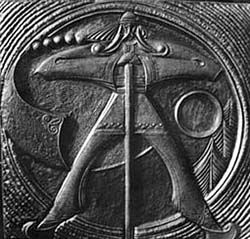Artist of the Carpathians

In the early 1970s Mykhailo Kateryniuk was called a “wizard” of wood and metal. This young member of the Artists’ Union of Ukraine was named Merited Master of Folk Art when he was only 23.
His talent was obvious and indisputable at a young age. Eloquent images of engraved and embossed carvings and the artist’s brilliant artistic gift impressed the general public and attracted the attention of experts. Today a collection of Kateryniuk’s works from the 1960s-1980s is on display at the Chernivtsi Art Museum.
Kateryniuk’s early engravings displayed definitive traits of a master, such as national and ethnographic coloring, expressiveness of imagery, and exceptional artistry. A sublime example is “The Master of the Carpathians” (1970), a work that possesses a unique energy charge. This is a classical composition shows the figure of a man inscribed in a circle. With exceptional expressiveness he brings to life an image that is dear to him: a Hutsul legin, which became a centerpiece of his later work. The highlanders’ freedom-loving ideals, their courage and infatuation with the nature of their homeland are leitmotifs in such works as “Brigands,” “Storm” (1978), and “Morning” (1985).
The heroic and romantic expressions of his plastic works are inseparably connected with the poetic and folkloric grasp of images. Kateryniuk’s Carpathian characters are subtle musical creatures and passionate dancers. Their devoted companions are the trembita (Alpine horn) penny-whistle, dulcimer, and violin. The artist gives an original interpretation to the theme and complete image of the Hutsul musician in his early work “Melody of the Grey Mountains” (1969; also known as “Melody of the Carpathians”). He continued this motif throughout the years and developed it by means of an engraving technique featured in the works “Brigand’s Dance,” “Melody, the series “Troisti Muzyky (three musicians), and “Conversation with the Mountains.” Among his carvings is a series of reliefs, including “Hutsul Hubbub,” “Dance of the Woodcutters,” “Melody,” “Morning,” etc.
An important feature of Kateryniuk’s oeuvre is the vivid embodiment of the national traits and character of the Ukrainian Hutsul highlanders. Touching lyricism and wonderful melodics distinguish most of his works. However, in the forefront are such superb relief carvings as “Kupalo Motif” and “Youth of the Carpathians.” The artist sang paians of love with his heart. He was able to personify unaffected tenderness, lyrical admiration, and the highest manifestation of beauty in his generalized images of Ukrainians.
The expressiveness of Kateryniuk’s works reveals an innovative approach. He resorts to various techniques to achieve profound expressiveness. In “Kupalo Motif” the figure of a girl lowering a wreath into the water is placed against the background of a river depicted by wavy lines of damascenes. They match the lively ribbons in the girl’s braids, flying in the wind.
The drama of the wonderful relief “Youth of the Carpathians” exhibited in the Chernivtsi Regional History Museum is more acute because of the contrast between the energetic movements of the horses and peaceful idyll of the lovers. Interestingly, despite the composition’s horizontal orientation, a dynamic feeling is created by a sophisticated rhythmic system. Psychological tension is emphasized by movements in different directions: horses’ heads, lovers’ hands, and flying swallows, birds that are considered sacred in Ukrainian folklore — symbols of love and tenderness. Simultaneously, the dominant acuity of movement is intensified by the expressive curves of the horses and ribbons that fly and wrap around the girl’s figure. There is always a horse next to a freedom-loving Hutsul, his “faithful brother.”
The artist often depicts horses as symbols of fidelity, devotion, and unrestrained passions. A special feature of this work is the introduction of a vertical image — the Hutsul’s ax — into the horizontal composition. This detail brings psychological balance symbolizing decisiveness, certainty of happiness, and definite contours of destiny.
In contrast to this work, the charming composition “Melody” (1985) is characterized by a high level of generalization and impressive completeness of artistic expression. The monumental figure of a man playing the penny-whistle is shown in an austere and static way against the background of a mountain landscape. This unforgettable image personifies harmony and peace.
Graphic tools are extremely restrictive. Through the expressive play of light and shadow the author skillfully creates volume and deepened relief. The artist’s chisel picks the wood with masterful and precise movements and outlines the musician’s head and shoulders with a soft, elongated line in such a way that it harmonizes with the mountain contours that rise above him. The air is filled with melodious sounds. The wind’s breath transports them to the mountains and the sky, caressing the whistle-player’s hair. The words of Ivan Franko come to mind: “And we can hear the boundless expanses of time.” (“From the Secrets of Poetic Creativity”).
A holistic image of the Hutsul carved by Kateryniuk acquires epic meaning and a lofty poetic character. The artist vividly interprets the theme of organic unity between man and nature, which is predominant in the artist’s oeuvre. There is another persuasive and characteristic detail present in the early work “Melody of the Grey Mountains” (metal, engraving) as well as in some later works: the similarity between the artist’s likeness and the characters that feature in his works. Kateryniuk eloquently displays this resemblance in his older age. It seems that his own special expressive appearance was inherited both from his parents and his artistic images.
Kateryniuk established himself in Ukrainian art with a range of image-oriented original works. One of the striking traits of the artist’s body of work is the national coloring of his plastics, which he emphasizes in a noble and restrained fashion, decorating it with traditional ornamental elements. He eloquently conveys the main artistic idea of the work through sheer plastic means. His work material consists of blessed Carpathian wood “from whose body the artist carves everything he needs to maintain the integral image in his imagination,” says the artist’s friend Vasyl Babukh.






